Toshiba and SanDisk Announce 48-layer 256Gbit TLC 3D NAND
by Billy Tallis on August 4, 2015 11:00 AM EST
This week Toshiba and SanDisk are announcing a new milestone in their joint development of flash memory. Back in March Toshiba announced a 48-layer 3D NAND technology that they were sampling in the form of a 128Gb MLC die. Now Toshiba and partner SanDisk have built a 256Gb TLC die on their 48-layer process. Toshiba will be sampling that chip starting in September, and SanDisk has selected it as their first 3D NAND device for mass production.
Central to this development is the outfitting of Fab 2 at their facility in Yokkaichi, Japan. The previous Fab 2 was demolished in 2014 and construction started on a replacement to be used as their first fab for 3D NAND. The new Fab 2 has now started pilot production of 3D NAND as it is being readied for mass production, scheduled to begin in 2016. Toshiba says the fab will be completed in the first half of the year and SanDisk plans to be shipping products using their 3D NAND by the end of the year.
The new 3D NAND will face experienced competition from Samsung who are currently shipping 32-layer 3D NAND in capacities up to 128Gb for both MLC and TLC configurations. Samsung has also announced its third generation V-NAND which should be starting mass production in the latter half of this year. Meanwhile, Intel and Micron have stated that their 32-layer 3D NAND will be in mass production by the fourth quarter of this year in the form of a 256Gb MLC die and a 384Gb TLC die. SK Hynix is to begin mass production of a 36-layer 128Gb MLC die during the third quarter and is working toward a 48-layer TLC that will be available in 2016.
All of the major flash manufacturers have now publicized their plans for introducing 3D NAND. Planar NAND won't be disappearing overnight or even in a year, as it takes a lot of time and money to convert a fab to a new process. But from here on out, we can expect all the most interesting news about NAND flash memory to be about 3D.
Source: Toshiba & Sandisk










28 Comments
View All Comments
lilmoe - Tuesday, August 4, 2015 - link
Numbers don't lie, really.Drumsticks - Tuesday, August 4, 2015 - link
What's your point though? Samsung doesn't have a monopoly on the know-how or capability to do a TLC drive with an SLC cache.lilmoe - Tuesday, August 4, 2015 - link
I thought my original post was self explanatory. My problem isn't with a brand, nor other 3D NAND, you need a good controller, good cache AND competitive pricing if you want to beat Samsung's TLC offering... No bias, no BS, and no smartass intended.Gigaplex - Tuesday, August 4, 2015 - link
Except you've competely ignored the fact that other manufacturers could build a good controller. The Samsung controller doesn't have a lot of fancy IP, it's mostly an off the shelf 3 core ARM unit. Other manufacturers already do SLC caching, and you can't just discount their firmware efforts by pointing at current benchmarks as those drives are underperforming in other areas. The Crucial drives give pretty decent competition to the Samsung drives already.lilmoe - Tuesday, August 4, 2015 - link
Again, you're completely off. Not point at all. Look at the competing TLC offering(s); performance, price, and value... They're perfectly capable of at least getting similar results, but they're not. Whatever SLC caching they're doing on their TLC ain't working. Therefore, nothing's worth looking at, when TLC is concerned, except for Samsung's offering ATM.I'm honestly curious, what other TLC SSD would you recommend (maybe even to yourself)?
Oxford Guy - Wednesday, August 5, 2015 - link
MLCchrnochime - Wednesday, August 5, 2015 - link
Except not everyone cares about price AND insist on using TLC as much as you do. I'd pick any other company and/or pay a bit more money for MLC before I go with them, and it's not because of stubborn bias/faboyism.upsidedownfunnel - Wednesday, August 5, 2015 - link
If they "could" do these things why don't they? How does Samsung offer an SSD that is one of the cheapest yet one of the fastest on the market? If other OEMs could do this, why wouldn't they?Aries1470 - Tuesday, August 11, 2015 - link
The reason Samsung can do this, is that they are a "Vertical" company. They have their own foundries, manufacturing and distribution. They do not need to rely on 3rd party and pay "extra" costs. So they control the whole chain. I hope that answers your question, same as Intel for example too... start of die to finished product.Impulses - Tuesday, August 4, 2015 - link
Thanks for tallying up where all the players stand, it's exactly what I was wondering after the first paragraph...Looks like it'll be a few more months until we see any pricing impact due to new 3D NAND sources... Hopefully I can find a cheaper 1TB EVO by year's end, should've just bought the second one when Newegg had them at $310 on eBay.